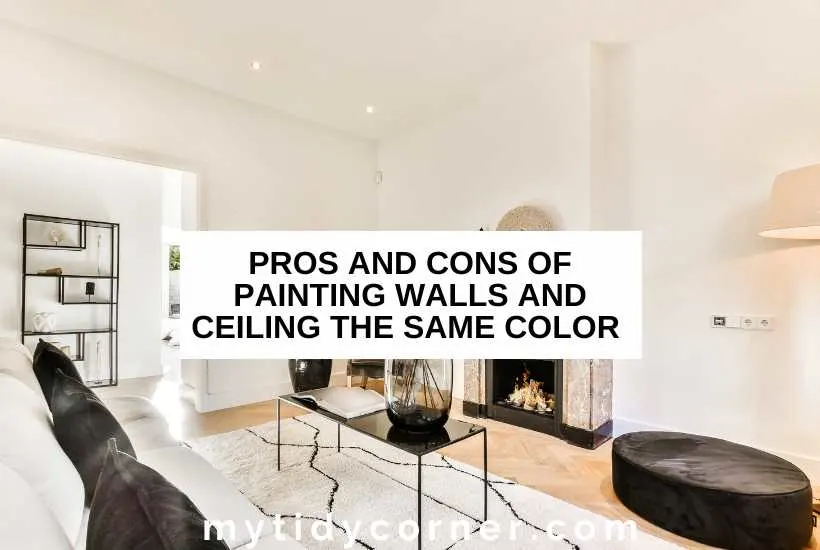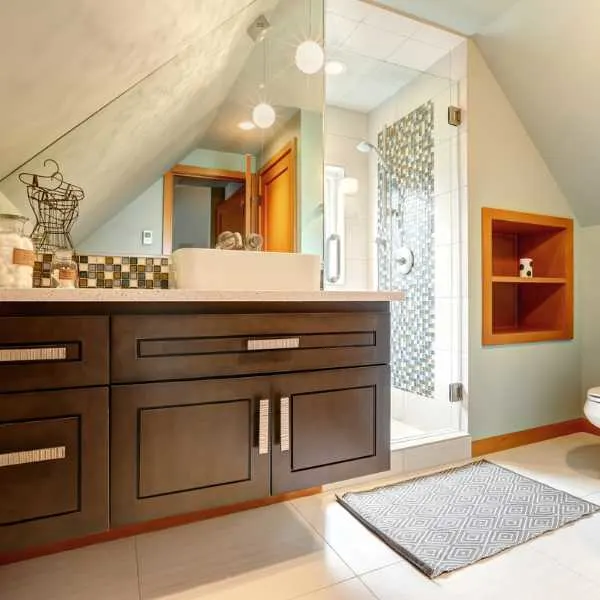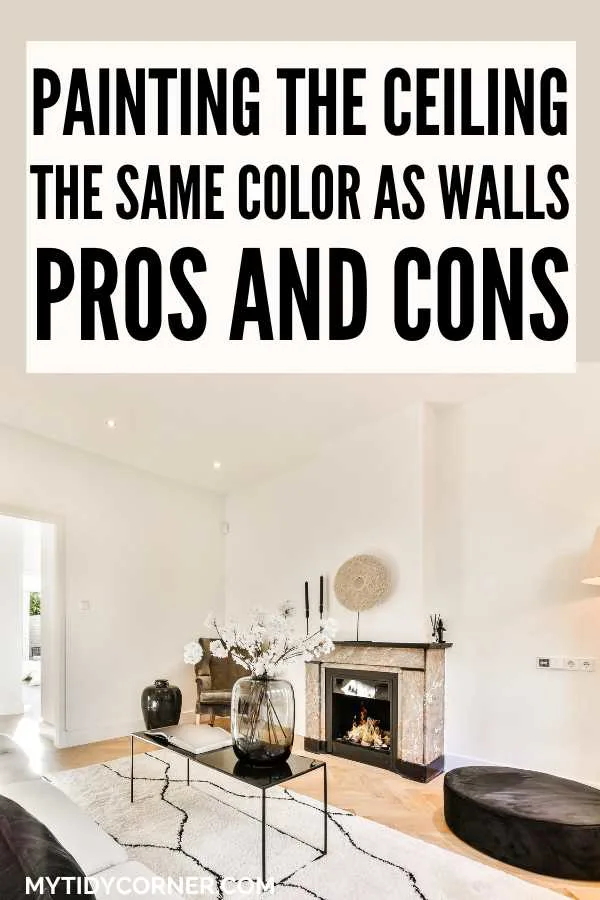Discover the pros and cons of painting walls and ceiling the same color to help you make an informed decision.
Whether you are planning a room renovation or just looking for a new paint job done, you will need to decide whether or not you want the ceiling and walls same color.
A new paint job is one of the cost effect ways to give a room a face lift on a budget. So, do you paint the ceiling the same color as the walls or not? Read on to learn about the pros and cons of painting the ceiling the same color as walls.
Painting the ceiling the same color as the walls means fewer decisions, an easier paint job, a cost-effective, and creating continuity, positive mood, and space. However, using the incorrect paint quality, hiding design features, and creating a boring or overwhelming effect is a problem.
The color of your walls and ceiling can impact your mood and how big, airy, and quirky the room looks. Apart from deciding what color to paint a room, you also need to determine whether the walls and ceiling should be the same color.
Let’s examine the pros and cons of painting your ceiling and walls the same color.

Related Articles:
- Best Wall and Ceiling Color Combinations
- What Color Should I Paint My Basement Ceiling?
- 13 Best Greige Paint Colors of the Year
- Trending Paint Colors of the Year
Pros of Painting Walls and Ceiling Same Color
The trend to minimalism in interior design has led to rooms being monochromatic, that is, all one color. There are advantages to painting ceilings and walls the same color, a process known as room wrapping.
Fewer Decisions
The significant advantage of painting your walls and ceiling the same color is that it’s one less decision to take in the long list of remodeling choices.
A single color is an easy choice, especially when considering the alternative: trying to match two colors is tricky, especially in a small space like a bathroom.
I wanted to paint my bathroom a gorgeous turquoise, with the ceiling a lighter shade.
However, choosing a lighter shade with the same blue undertone was extremely tricky, as the blue and green undertones in turquoise don’t always play off each other. Ending up with the slightly wrong shade will bother me forever, so I went with an all-turquoise jewel of a room.
(You may also want to read this article about the best paint color ideas for a small bathroom with no natural light.)
Another consideration with more than one color is deciding where one color begins and ends. Any unusually shaped room, such as with angled ceilings defies the definition of which bits are walls and which are ceilings. A single color is practical.
Quick Paint Job
Painting a room a single color is easier from the painter’s point of view. For example, there is no need to tape around the moldings, spend time getting edges perfect, or fix drips on the wall.
The painter can also paint all surfaces simultaneously, not having to wait for the paint to dry in between to avoid drips and smears. (And nobody likes watching paint dry. It isn’t very interesting.)
Cost-Effective
Painting the ceiling the same color as walls is also more cost-effective.
For a start, you’ll have to buy only one color of paint and can judge how much to use, rather than leaving a half-empty tin languishing in the store room.
Labor costs will also be cheaper as your painter won’t have to spend time taping and perfecting edges.
Environmentally Friendly
Paint may not be the most expensive element when remodeling. However, wastage is not environmentally friendly, whether extra paint tins or unused leftover paint. Choosing a single color means you can judge the amount of paint needed.
Camouflage
Wrapping the room in a monochrome color can hide imperfections in the build quality.
Paint will camouflage imperfections in walls and ceilings, such as angles that aren’t quite straight, gaps in the molding, poor plastering, or an odd slope to the ceiling.
Painting the walls and ceiling the same matte color can hide an old-fashioned knotty pine ceiling and draw attention away from an ugly popcorn ceiling.

Continuity
Use a monochromatic color palette to achieve a flowing effect in a room.
If you have a modest home with small rooms, painting walls and ceilings the same color creates a sense of cohesion instead of a series of disjointed rooms. The impact is one of elegance and sophistication rather than size.
A single design theme can also be tied together using one simple color.
Creates a Mood
Wrapping a room in your favorite color can create a desired mood. Treat your ceiling as the fifth wall – don’t underestimate how effective a simple palette can be.
Here are some of my most loved monochrome schemes and their impact.
Clean, Serene Neutrals
A white or neutral color choice (taupe, beige, greige, or gray) in a room has an immediate effect. For a start, your bathroom looks clean and crisp.
A light-colored room is also serene, as there are no intense color combinations and contrasts to add tension. You can create a relaxed and inviting space.
The trend to neutral colors remains popular and gives any room a good resale value.
Pale, Light, And Airy
Smaller rooms and windowless bathrooms can look poky and dark. However, choosing to paint the walls and ceiling white, pale yellow, grey, or blue can make your room look larger and brighter than it is.
First, lighter colors reflect any natural or artificial light in the room, magnifying the brightness and distributing it around the room. My sister’s attic bathroom is a pearly gray and feels like the inside of a beautiful egg.
Second, a uniform swathe of light color from floor to ceiling makes the ceiling immediately seem higher and the room more airy and spacious. Two contrasting colors cut off the height of the walls and make the ceiling seem lower.
Deep, Dark Space
Oddly enough, small spaces don’t always need light colors to create the illusion of space.
A space-starved room can look larger if wrapped in a darker color. Instead of the room looking heavy and closed, your eyes are tricked into seeing a receding space.
If you enjoy experimenting with color, a beautiful dark blue or slate grey elongates the room, making the ceiling seem higher.
Cons of Painting the Ceiling and Walls the Same Color
While painting your walls and ceiling the same color has many advantages, there are also some drawbacks.
Incorrect Paint Quality
Trying to save money using the same paint on the walls and ceiling can backfire. Paint for ceilings in a place like the bathroom is of a higher quality than wall paint. It needs to be durable and cope with moisture and humidity. Using the incorrect paint can lead to a stained or moldy ceiling.
It Can Hide Design Features
While a monochrome color scheme can hide imperfections in your bathroom, it can also hide features you’d like to highlight.
Beautiful molding, cornices, or an unusual roof shape can disappear under a layer of dark paint. Choosing a light color that contrasts with the walls will allow these features to stand out and be enjoyed.
Creates a Mood
While a monochromatic scheme can create a pleasing effect in your bathroom, some color schemes have the opposite effect. Take care when choosing your palette so that you can avoid these disasters.
Monotonous and Stark
Using a monochrome color scheme throughout a bathroom can be bland, especially if you stick to white. Instead of looking serene and airy, the room can be sterile and cold.
Combining colors or even using shades of a single color can add interest and appeal to your room.
Dark and Depressing
While dark shades can be dramatic and exciting, painting a small room too dark and flat a color can overwhelm the room. Instead of giving a sense of depth, the space will be overwhelmed.
Dark colors in a small or windowless basement with no natural light can create a depressing, low mood so take care when choosing your shade.
Small and Poky
Without a focal point, a monochromatic scheme lacks visual interest. The eye moves over the room in a continual flow but has nowhere to stop and rest. The room will seem smaller as a result.
Painting your ceiling white or a lighter color will immediately open up the room, offering a point of contrast to draw the eye.
Another challenge is that unless you choose the correct shade, the light won’t reflect around the room, making it seem poky and smaller than it is.
A Monochromatic Compromise
A compromise between a single-color wrap and a totally contrasting ceiling color is to mix a lighter version of the same color for the ceiling.
Ideally, make the ceiling color 20-50% lighter than the walls to add contrast, make the room seem brighter, and lift the ceiling.
Another option is to change the texture of the ceiling, using, for instance, a high gloss effect or lacquer finish in the same color as the walls. This works best on smoothly plastered ceilings, as all imperfections will be highlighted.
A third compromise is to paint only a single wall and the ceiling the same color – like having two accent walls in a room. Painting the other walls in a neutral shade will prevent a monochrome color from dominating and offer an attractive focal point to the room.
Final Thoughts on Painting the Ceiling the Same Color as Walls
Painting your walls and ceiling the same color can save you time and money and create a pleasingly cohesive effect. However, while some colors make a room look airy and bright, a single color can also leave a room looking stark or dark. Compromise by using a lighter shade for the ceiling and ensure it is the correct quality paint.
Did you find the pros and cons of painting walls and ceiling the same color helpful? Leave your comment below.

